Tons of food from around the
world have arrived in the Philippines, but the hundreds of thousands homeless
and hungry after Typhoon Haiyan decimated part of the country have yet to get a
bite of it.
Endless landscapes of devastation
were still blocking roads leading to the hardest hit areas Wednesday.
The World Food Programme has
delivered at least 2,700 tons of rice to the country, but the logistical
nightmare of traveling to the many islands ripped to pieces by one of the
strongest storms in recorded history has it arriving in drips and drabs.
Clearing roads and runways has
taken a long time, UNICEF spokesman Christopher De Bono said.
 A man looks at his home destroyed by Typhoon Hayian in
Tacloban, Philippines, on Wednesday, November, 13. Haiyan, one of the strongest
storms in recorded history, decimated parts of the Philippines. President
Benigno Aquino III said the typhoon may have killed as many as 2,500
people.
A man looks at his home destroyed by Typhoon Hayian in
Tacloban, Philippines, on Wednesday, November, 13. Haiyan, one of the strongest
storms in recorded history, decimated parts of the Philippines. President
Benigno Aquino III said the typhoon may have killed as many as 2,500
people.
Survivors prepare to board a military plane November 13 at
the airport in Tacloban, one of the hardest-hit cities.
An aerial view shows signs pleading for help and food
scrawled on a road in the coastal town of Tanauan on November 13.
Soldiers help a woman after she collapsed while waiting in
line to board a military plane at Tacloban's airport November 13.
Survivors wait to be evacuated from Tacloban on November
13.
An injured survivor gets carried on a stretcher before
being airlifted from Tacloban's airport November 13.
A survivor begins to rebuild his house in Tacloban on
November 13.
Evacuees wait to board a military aircraft in Leyte on
Tuesday, November 12.
Police line up bodies for processing in Tacloban on
November 12.
People walk through damage in Tacloban on November
12.
A young man waits at the airport November 12 in hopes of
being evacuated from Tacloban.
A woman comforts a crying relative as a plane leaves the
Tacloban airport November 12.
A man sits crying on a packed aircraft in Tacloban on
November 12.
Debris lays scattered around a damaged home near the
Tacloban airport on November 12.
A girl sits inside a bus as she waits for a ferry in
Matnog, Philippines, on November 12.
Residents carry bags of rice from a Tacloban warehouse
that they stormed November 11 because of a food shortage.
Survivors in Tacloban board a military plane bound for the
Philippine capital of Manila on November 11.
People in Tacloban pass debris on November 11.
A woman in Tacloban walks amid the debris of destroyed
houses on November 11.
People make their way across a flooded street in Shangsi,
China, on November 11. Haiyan moved toward Vietnam and south China after
devastating the Philippines.
Buildings lie in ruins on Eastern Samar's Victory
Island.
Emily Ortega rests on November 11 after giving birth to
Bea Joy at an improvised clinic at the Tacloban airport.
U.S. Marine Corps Osprey aircraft arrive at Manila's
Villamor Airbase to deliver humanitarian aid on November 11.
People ride past destruction in Tacloban on Sunday,
November 10.
A body lies amid the Tacloban devastation on November
10.
People cover their noses to block the smell of bodies in
Tacloban on November 10.
Bodies of victims lie along a Tacloban road on November
10.
A large boat sits aground, surrounded by debris in
Tacloban on November 10.
People walk past the Tacloban devastation on November
10.
People stand under a shelter in Tacloban.
A girl peeks out from a makeshift shelter in
Tacloban.
Typhoon survivors wait to receive relief goods at the
Tacloban airport on November 10.
A woman mourns in front of her husband's dead body
November 10 in Tacloban.
Fallen trees litter the ground at the Tacloban airport on
Saturday, November 9.
A resident passes victims' bodies on a Tacloban street
November 9.
People in Tacloban carry a victim of the typhoon November
9.
A vehicle lies amid Tacloban debris on November 9.
People walk past a victim left on the side of a road in
Tacloban.
A resident passes an overturned car in Tacloban on
November 9.
Rescue workers carry a woman about to give birth November
9 at a makeshift medical center at the Tacloban airport.
An airport lies in ruins in Tacloban.
Astronaut Karen L. Nyberg took a picture of the typhoon
from the International Space Station on November 9.
Women walk past fallen trees and destroyed houses in
Tacloban on November 9. Residents scoured supermarkets for water and food as
they slowly emerged on streets littered with debris.
A soldier pulls a cable inside the devastated airport
tower in Tacloban.
Tacloban houses are destroyed by the strong winds caused
by the typhoon.
Dark clouds brought by Haiyan loom over Manila skyscrapers
on November 8.
A woman carries a baby across a river November 8 at a
coastal village in Las Pinas, Philippines.
A resident walks along a fishing village in Bacoor,
Philippines, on November 8.
A house in Legazpi, Philippines, is engulfed by storm
surge November 8.
A child wraps himself in a blanket inside a makeshift
house along a Bacoor fishing village.
A woman and her children head for an evacuation center
November 8 amid strong winds in Cebu City, Philippines.
Huge waves from Haiyan hit the shoreline in Legazpi on
November 8.
A fisherman lifts a post to reinforce his home at a
coastal village in Las Pinas on November 8.
A resident unloads nets off a fishing boat in Bacoor on
November 8.
Residents reinforce their homes in Las Pinas on November
8.
The storm approaches the Philippines in this satellite
image taken Thursday, November 7, by the National Oceanic and Atmospheric
Administration.
Workers bring down a billboard in Makati, Philippines, on
November 7 before Haiyan makes landfall.
Philippine Coast Guard personnel stand in formation beside
newly acquired rubber boats after a blessing ceremony in Manila on Wednesday,
November 6. The boats were to be deployed to the central Philippines in
preparation for Haiyan.
Typhoon Haiyan
HIDE CAPTION
 Photos: Typhoon
Haiyan
Photos: Typhoon
Haiyan  Haiyan's track
Haiyan's track
Haiyan's
track
The level of desolation Haiyan
left behind in a country that is used to sitting out a barrage of typhoons every
year took aid organizations off guard, De Bono said.
"Nobody was quite able to
anticipate it."
Glimmer of
hope
"We need food; we need to eat!"
a crowd gathered and chanted, after a cargo plane full of food opened its
loading bay in Guiuan Tuesday.
The town of 50,000 was wiped off
the map by the storm Friday.
Haiyan made its first landfall
there. The storm left at least 2,275 people dead and injured 3,665 more,
according to the Philippine disaster agency.
The first food deliveries in
Guiuan and in Tacloban, the city hit hardest by the typhoon, represent a glimmer
of hope -- at least to aid workers. It's an initial sign of success after days
of frustration.
"Good news from Philippines,"
the UN food program announced Wednesday. "WFP food distributions underway in
Tacloban this morning. Rice provided to 3,000 people."
It's a start. But more than 2
million people need food aid, the Philippine government has said.
"I understand that that's not a
glimmer of hope for people on the ground, who are still waiting for assistance,"
De Bono said.
He hopes to see aid delivery
leap forward Wednesday. Many air strips have been cleared in devastated areas,
and one flight after another lands carrying basic food.
But CNN crews on the ground have
seen no sign yet of an organized cleanup or recovery operation in the most
desperate areas.
Help is long overdue, storm
survivor John Wynn told Anderson Cooper. "They need help now, not in a few days
or in a few hours."
In Guiuan, anticipation and
desperation spread across the faces of residents as they watched troops unload
bags of rice and boxes of bottled water from the C-130 cargo plane.
Many of them have been drinking
filthy water to survive. And that could endanger their health, since the storm
has strewn sewage into the water supply.
"The sanitation systems have
been destroyed and children are of course the most vulnerable to cholera, which
is a common occurrence after these kinds of disasters," De Bono said.
Decomposing
bodies
Bodies of storm victims still
lie in the debris, or out in the open. The government has not been able to count
all of them yet, but fears of an exponentially higher death toll have
subsided.
Authorities initially predicted
that Haiyan may have killed as many as 10,000 people, but Philippine President
Benigno Aquino III told CNN's Christiane Amanpour that the final number would
more likely be around 2,000 to 2,500.
Bodies decomposing in the sun
commonly raise fears that they could contribute to the spread of disease. But
that's usually not the case, said CNN's Dr. Sanjay Gupta.
"From a pure health threat
standpoint, there are bigger threats," he said. People need clean food and
water.
The slowness of food and basic
medical aid delivery is the biggest threat to lives, Gupta said.
"There are people there right
now who can be saved. And it could be as simple as antibiotics that cost a
penny."
On social media, a government
spokeswoman asked for donations of vaccines and antibiotics.
"We have 3k flu vaccines
already. Meds needed: tetanus toxoid, doxycycline, cloxacillin," Lucille
The World Health Organization
agrees with Gupta that illnesses are a secondary concern. "Disease is not a big
fear," said spokeswoman Julie Hall. Clean food and water take priority, as well
as shelter from the elements.
Homeless,
grieving
About half of the displaced have
crowded into evacuation centers. There are hundreds of thousands left without
homes, and aid organizations are struggling to get roofs over their heads.
"We're bringing in 20,000
shelter kits, hygiene kits," USAID spokesman Ben Hemingway said. Those shelter
kits are sheets of plastic that survivors can hang up over their heads, he
explained.
What happens with the bodies of
the dead is important to public health, even if the corpses don't significantly
spread disease, Hall said. Survivors need to know where they are to be able to
grieve and move on and take care of themselves.
In Tacloban, survivor Juan
Martinez can't do that yet.
He sits underneath a makeshift
shack where his home once stood. Nearby, the bodies of his wife and two children
are covered by sacks.
"I really want someone to
collect their bodies, so I know where they are taken," he told CNN's Anderson
Cooper. "I want to know where they are taken."
Daughter, son
dead; wife missing
Everybody in his town is
searching for somebody.
A dog led Yan Chow and a search
crew to the body of his daughter, buried underneath debris in Tacloban.
Chow had been looking for his
two children and his wife since the storm hit. He was texting with his daughter
when the messages suddenly stopped, about the time a massive storm surge may
have hit the city.
Her body was found not too far
from where they found her brother, some distance from their house, Chow
said.
He still does not know where his
wife is.
U.N.: 25 million
U.S.: 20 million
UK: 16.1 million
UAE: 10 million
Australia: 9.5 million
Canada: 4.8 million
European Union: 4 million
Norway: 3.4 million
Denmark: 3.1 million
New Zealand: 1.75 million
Ireland: 1.4 million
Vatican: 150,000
China: 100,000
There are thousands like him,
who have lost part or all of their families, many of them sitting next to their
corpses under makeshift shelters.
Traumatized
Tacloban
At a hospital in Tacloban, many
wait for treatment, but there is no electricity and few supplies. It was too
late for one young mother, who cradled her dead baby in her arms.
"I'm going crazy," she said. "I
want to go back home."
But home is gone.
Nine-year-old Rastin Teves made
it out of Tacloban, but will take the horrifying sights she saw there with her
for a long time.
"I've seen dead people on the
streets and the sidewalks," she said. "It made me feel scared."
The smell of decomposing bodies
also stuck with her. She watched people break into shops to take whatever they
needed.
Rays of
hope
A ray of hope broke through
Tacloban's dark misfortune Wednesday.
A team of 148 search and medical
workers departed Israel Wednesday with plans to set up an emergency hospital
there. They are bringing 100 tons of humanitarian and medical supplies with
them, Israel's foreign minister said.
The U.S. Marine Corps is sending
four more Osprey aircraft, it said Wednesday, bringing the total number of the
part-plane-part-helicopters to eight. Ospreys can land and take off in remote
areas like choppers, but fly further than helicopters on less fuel and carry
bigger payloads.
And authorities cleared a
landing strip in the neighboring province of Samar, the Philippine government
said, giving aid planes better access to the ravaged city.
Tacloban's own airport is choked
with survivors clamoring to get on a handful of flights out of the wreckage that
was once their city. Many are not getting out, and they have transformed the
airport into a homeless shelter.
The lucky
ones
In tragedy's midst, there are a
few happy stories.
Indiana residents Ron Johnston
and his wife, Charity, whose parents live in the devastated town of Baybay, were
overjoyed to hear that they survived the storm.
Charity Johnston last spoke to
her father on Thursday as Typhoon Haiyan was bearing down on the Philippines,
but a cousin found her parents and notified her that they were alive.
Their house is completely gone,
along with everything they own. "But they didn't lose the precious thing,"
Johnston said. "Life."
Hospitals caring for survivors
are overfilled, undersupplied and often have no electricity.
But in a hospital in Tacloban
this week, a baby was born. Neighbors brought the mother in after she went into
labor in the wreckage of the storm.
No complications, no bleeding. A
perfect delivery.
Doctors and other patients
erupted in applause.


 Survivors prepare to board a military plane November 13 at
the airport in Tacloban, one of the hardest-hit cities.
Survivors prepare to board a military plane November 13 at
the airport in Tacloban, one of the hardest-hit cities.
 An aerial view shows signs pleading for help and food
scrawled on a road in the coastal town of Tanauan on November 13.
An aerial view shows signs pleading for help and food
scrawled on a road in the coastal town of Tanauan on November 13.
 Soldiers help a woman after she collapsed while waiting in
line to board a military plane at Tacloban's airport November 13.
Soldiers help a woman after she collapsed while waiting in
line to board a military plane at Tacloban's airport November 13.
 Survivors wait to be evacuated from Tacloban on November
13.
Survivors wait to be evacuated from Tacloban on November
13.
 An injured survivor gets carried on a stretcher before
being airlifted from Tacloban's airport November 13.
An injured survivor gets carried on a stretcher before
being airlifted from Tacloban's airport November 13.
 A survivor begins to rebuild his house in Tacloban on
November 13.
A survivor begins to rebuild his house in Tacloban on
November 13.
 Evacuees wait to board a military aircraft in Leyte on
Tuesday, November 12.
Evacuees wait to board a military aircraft in Leyte on
Tuesday, November 12.
 Police line up bodies for processing in Tacloban on
November 12.
Police line up bodies for processing in Tacloban on
November 12.
 People walk through damage in Tacloban on November
12.
People walk through damage in Tacloban on November
12.
 A young man waits at the airport November 12 in hopes of
being evacuated from Tacloban.
A young man waits at the airport November 12 in hopes of
being evacuated from Tacloban.
 A woman comforts a crying relative as a plane leaves the
Tacloban airport November 12.
A woman comforts a crying relative as a plane leaves the
Tacloban airport November 12.
 A man sits crying on a packed aircraft in Tacloban on
November 12.
A man sits crying on a packed aircraft in Tacloban on
November 12.
 Debris lays scattered around a damaged home near the
Tacloban airport on November 12.
Debris lays scattered around a damaged home near the
Tacloban airport on November 12.
 A girl sits inside a bus as she waits for a ferry in
Matnog, Philippines, on November 12.
A girl sits inside a bus as she waits for a ferry in
Matnog, Philippines, on November 12.
 Residents carry bags of rice from a Tacloban warehouse
that they stormed November 11 because of a food shortage.
Residents carry bags of rice from a Tacloban warehouse
that they stormed November 11 because of a food shortage.
 Survivors in Tacloban board a military plane bound for the
Philippine capital of Manila on November 11.
Survivors in Tacloban board a military plane bound for the
Philippine capital of Manila on November 11.
 People in Tacloban pass debris on November 11.
People in Tacloban pass debris on November 11.
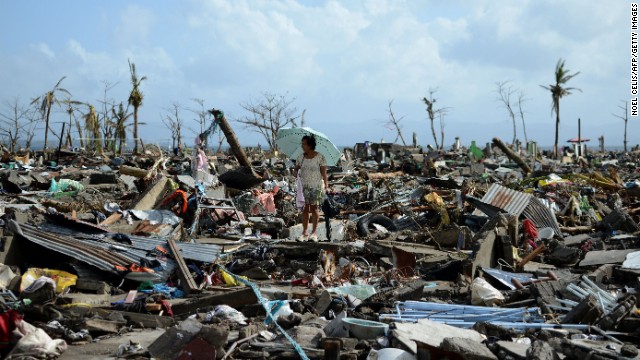 A woman in Tacloban walks amid the debris of destroyed
houses on November 11.
A woman in Tacloban walks amid the debris of destroyed
houses on November 11.
 People make their way across a flooded street in Shangsi,
China, on November 11. Haiyan moved toward Vietnam and south China after
devastating the Philippines.
People make their way across a flooded street in Shangsi,
China, on November 11. Haiyan moved toward Vietnam and south China after
devastating the Philippines.
 Buildings lie in ruins on Eastern Samar's Victory
Island.
Buildings lie in ruins on Eastern Samar's Victory
Island.
 Emily Ortega rests on November 11 after giving birth to
Bea Joy at an improvised clinic at the Tacloban airport.
Emily Ortega rests on November 11 after giving birth to
Bea Joy at an improvised clinic at the Tacloban airport.
 U.S. Marine Corps Osprey aircraft arrive at Manila's
Villamor Airbase to deliver humanitarian aid on November 11.
U.S. Marine Corps Osprey aircraft arrive at Manila's
Villamor Airbase to deliver humanitarian aid on November 11.
 People ride past destruction in Tacloban on Sunday,
November 10.
People ride past destruction in Tacloban on Sunday,
November 10.
 A body lies amid the Tacloban devastation on November
10.
A body lies amid the Tacloban devastation on November
10.
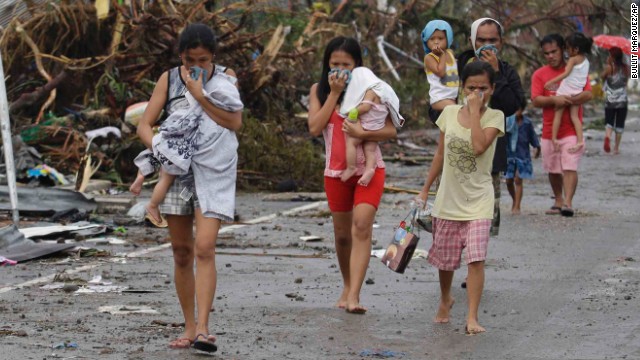 People cover their noses to block the smell of bodies in
Tacloban on November 10.
People cover their noses to block the smell of bodies in
Tacloban on November 10.
 Bodies of victims lie along a Tacloban road on November
10.
Bodies of victims lie along a Tacloban road on November
10.
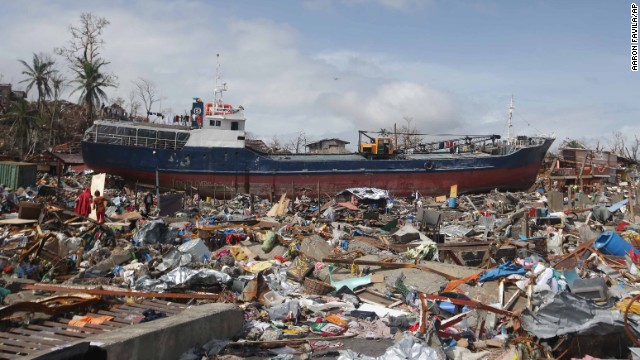 A large boat sits aground, surrounded by debris in
Tacloban on November 10.
A large boat sits aground, surrounded by debris in
Tacloban on November 10.
 People walk past the Tacloban devastation on November
10.
People walk past the Tacloban devastation on November
10.
 People stand under a shelter in Tacloban.
People stand under a shelter in Tacloban.
 A girl peeks out from a makeshift shelter in
Tacloban.
A girl peeks out from a makeshift shelter in
Tacloban.
 Typhoon survivors wait to receive relief goods at the
Tacloban airport on November 10.
Typhoon survivors wait to receive relief goods at the
Tacloban airport on November 10.
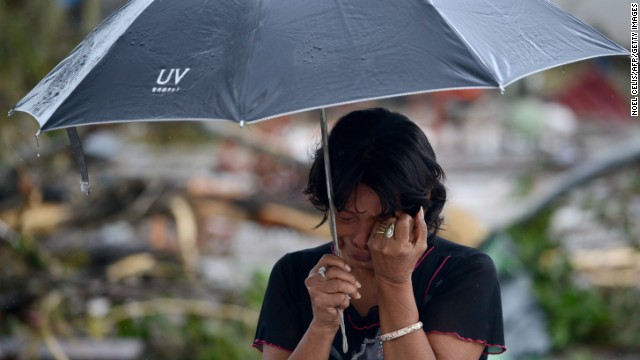 A woman mourns in front of her husband's dead body
November 10 in Tacloban.
A woman mourns in front of her husband's dead body
November 10 in Tacloban.
 Fallen trees litter the ground at the Tacloban airport on
Saturday, November 9.
Fallen trees litter the ground at the Tacloban airport on
Saturday, November 9.
 A resident passes victims' bodies on a Tacloban street
November 9.
A resident passes victims' bodies on a Tacloban street
November 9.
 People in Tacloban carry a victim of the typhoon November
9.
People in Tacloban carry a victim of the typhoon November
9.
 A vehicle lies amid Tacloban debris on November 9.
A vehicle lies amid Tacloban debris on November 9.
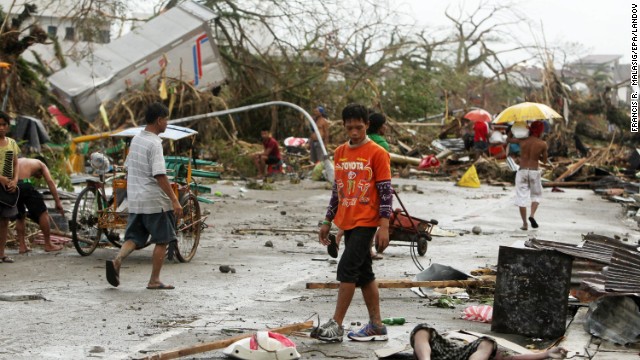 People walk past a victim left on the side of a road in
Tacloban.
People walk past a victim left on the side of a road in
Tacloban.
 A resident passes an overturned car in Tacloban on
November 9.
A resident passes an overturned car in Tacloban on
November 9.
 Rescue workers carry a woman about to give birth November
9 at a makeshift medical center at the Tacloban airport.
Rescue workers carry a woman about to give birth November
9 at a makeshift medical center at the Tacloban airport.
 An airport lies in ruins in Tacloban.
An airport lies in ruins in Tacloban.
 Astronaut Karen L. Nyberg took a picture of the typhoon
from the International Space Station on November 9.
Astronaut Karen L. Nyberg took a picture of the typhoon
from the International Space Station on November 9.
 Women walk past fallen trees and destroyed houses in
Tacloban on November 9. Residents scoured supermarkets for water and food as
they slowly emerged on streets littered with debris.
Women walk past fallen trees and destroyed houses in
Tacloban on November 9. Residents scoured supermarkets for water and food as
they slowly emerged on streets littered with debris.
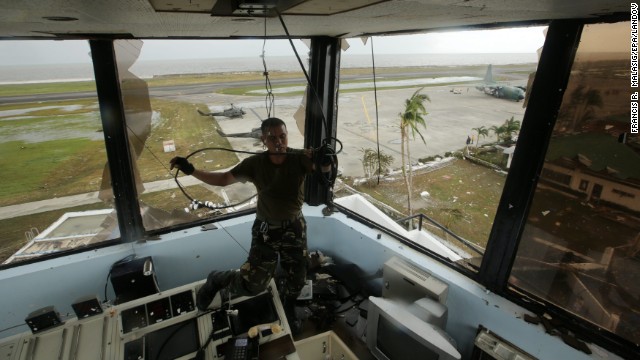 A soldier pulls a cable inside the devastated airport
tower in Tacloban.
A soldier pulls a cable inside the devastated airport
tower in Tacloban.
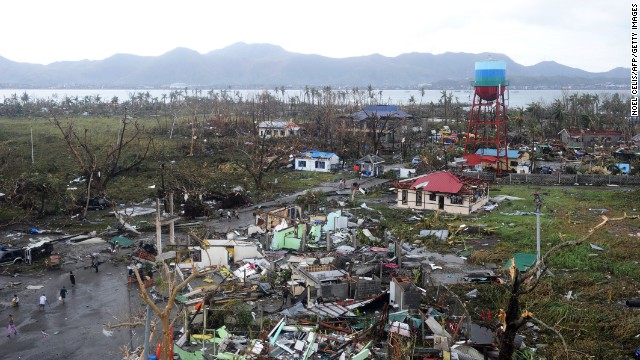 Tacloban houses are destroyed by the strong winds caused
by the typhoon.
Tacloban houses are destroyed by the strong winds caused
by the typhoon.
 Dark clouds brought by Haiyan loom over Manila skyscrapers
on November 8.
Dark clouds brought by Haiyan loom over Manila skyscrapers
on November 8.
 A woman carries a baby across a river November 8 at a
coastal village in Las Pinas, Philippines.
A woman carries a baby across a river November 8 at a
coastal village in Las Pinas, Philippines.
 A resident walks along a fishing village in Bacoor,
Philippines, on November 8.
A resident walks along a fishing village in Bacoor,
Philippines, on November 8.
 A house in Legazpi, Philippines, is engulfed by storm
surge November 8.
A house in Legazpi, Philippines, is engulfed by storm
surge November 8.
 A child wraps himself in a blanket inside a makeshift
house along a Bacoor fishing village.
A child wraps himself in a blanket inside a makeshift
house along a Bacoor fishing village.
 A woman and her children head for an evacuation center
November 8 amid strong winds in Cebu City, Philippines.
A woman and her children head for an evacuation center
November 8 amid strong winds in Cebu City, Philippines.
 Huge waves from Haiyan hit the shoreline in Legazpi on
November 8.
Huge waves from Haiyan hit the shoreline in Legazpi on
November 8.
 A fisherman lifts a post to reinforce his home at a
coastal village in Las Pinas on November 8.
A fisherman lifts a post to reinforce his home at a
coastal village in Las Pinas on November 8.
 A resident unloads nets off a fishing boat in Bacoor on
November 8.
A resident unloads nets off a fishing boat in Bacoor on
November 8.
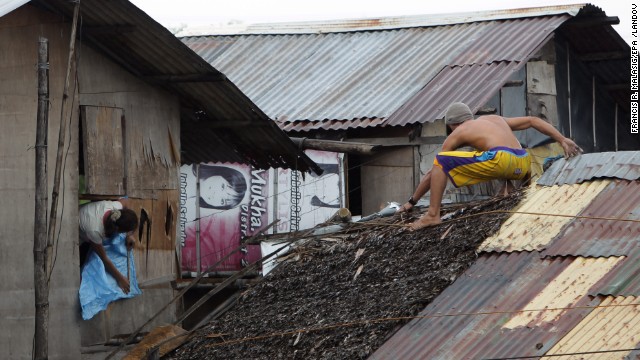 Residents reinforce their homes in Las Pinas on November
8.
Residents reinforce their homes in Las Pinas on November
8.
 The storm approaches the Philippines in this satellite
image taken Thursday, November 7, by the National Oceanic and Atmospheric
Administration.
The storm approaches the Philippines in this satellite
image taken Thursday, November 7, by the National Oceanic and Atmospheric
Administration.
 Workers bring down a billboard in Makati, Philippines, on
November 7 before Haiyan makes landfall.
Workers bring down a billboard in Makati, Philippines, on
November 7 before Haiyan makes landfall.
 Philippine Coast Guard personnel stand in formation beside
newly acquired rubber boats after a blessing ceremony in Manila on Wednesday,
November 6. The boats were to be deployed to the central Philippines in
preparation for Haiyan.
Philippine Coast Guard personnel stand in formation beside
newly acquired rubber boats after a blessing ceremony in Manila on Wednesday,
November 6. The boats were to be deployed to the central Philippines in
preparation for Haiyan.
































































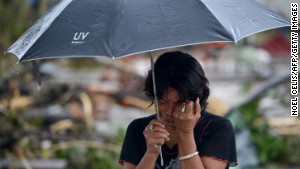
No comments:
Post a Comment